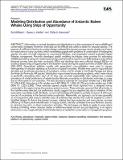Files in this item
Modeling distribution and abundance of Antarctic baleen whales using ships of opportunity
Item metadata
| dc.contributor.author | Williams, Robert | |
| dc.contributor.author | Hedley, Sharon L. | |
| dc.contributor.author | Hammond, Philip Steven | |
| dc.date.accessioned | 2012-06-27T16:01:01Z | |
| dc.date.available | 2012-06-27T16:01:01Z | |
| dc.date.issued | 2006-06 | |
| dc.identifier | 675886 | |
| dc.identifier | 4f9117c1-fcc6-4b0c-907c-2d357191ac7b | |
| dc.identifier | 000239121300002 | |
| dc.identifier | 33745892375 | |
| dc.identifier.citation | Williams , R , Hedley , S L & Hammond , P S 2006 , ' Modeling distribution and abundance of Antarctic baleen whales using ships of opportunity ' , Ecology and Society , vol. 11 , no. 1 , 1 . | en |
| dc.identifier.issn | 1708-3087 | |
| dc.identifier.other | ORCID: /0000-0002-2381-8302/work/47531652 | |
| dc.identifier.uri | https://hdl.handle.net/10023/2857 | |
| dc.description.abstract | Information on animal abundance and distribution is at the cornerstone of many wildlife and conservation strategies. However, these data can be difficult and costly to obtain for cetacean species. The expense of sufficient ship time to conduct design-unbiased line transect surveys may be simply out of reach for researchers in many countries, which nonetheless grapple with problems of conservation of endangered species, by-catch of small cetaceans in commercial fisheries, and progression toward ecosystem-based fisheries management. Recently developed spatial modeling techniques show promise for estimating wildlife abundance using non-randomized surveys, but have yet to receive much field-testing in areas where designed surveys have also been conducted. Effort and sightings data were collected along 9 650 km of transects aboard ships of opportunity in the Southern Ocean during the austral summers of 2000 - 2001 and 2001 - 2002. Generalized additive models with generalized cross-validation were used to express heterogeneity of cetacean sightings as functions of spatial covariates. Models were used to map predicted densities and to estimate abundance of humpback, minke, and fin whales in the Drake Passage and along the Antarctic Peninsula. All species' distribution maps showed strong density gradients, which were robust to jackknife resampling when each of 14 trips was removed sequentially with replacement. Looped animations of model predictions of whale density illustrate uncertainty in distribution estimates in a way that is informative to non-scientists. The best abundance estimate for humpback whales was 1 829 (95% CI: 978- 3 422). Abundance of fin whales was 4 487 ( 95% CI: 1 326 - 15 179) and minke whales was 1,544 ( 95% CI: 1,221 - 1,953). These estimates agreed roughly with those reported from a designed survey conducted in the region during the previous austral summer. These estimates assumed that all animals on the trackline were detected, but preliminary results suggest that any negative bias due to violation of this assumption was likely small. Similarly, current methodological limitations prohibit inclusion of all known sources of uncertainty in the favored variance estimator. Meanwhile, our approach can be seen generally as an inexpensive pilot study to identify areas of predicted high density that could be targeted to: inform stratified designs for future line transect surveys, making them less expensive and more precise; increase efficiency of future photo-identification or biopsy studies; identify candidate time-area fisheries closures to minimize by-catch; or direct ecotourism activities. The techniques are likely to apply to areas where funding is limiting, where cetacean studies or wilderness-based tourism are just beginning, or in regions where even a very rough estimate of animal abundance is needed for conservation or management purposes. | |
| dc.format.extent | 28 | |
| dc.format.extent | 375703 | |
| dc.language.iso | eng | |
| dc.relation.ispartof | Ecology and Society | en |
| dc.subject | Abundance | en |
| dc.subject | Antarctic | en |
| dc.subject | Baleen whale | en |
| dc.subject | Cetacean | en |
| dc.subject | Distance sampling | en |
| dc.subject | Distribution | en |
| dc.subject | Line transect | en |
| dc.subject | Platform of opportunity | en |
| dc.subject | Spatial model | en |
| dc.subject | Coastal British Columbia | en |
| dc.subject | Line transect surveys | en |
| dc.subject | Social-organization | en |
| dc.subject | Relative abundance | en |
| dc.subject | Harbor porpoises | en |
| dc.subject | South Georgia | en |
| dc.subject | Jackknife | en |
| dc.subject | Cetaceans | en |
| dc.subject | Mortality | en |
| dc.subject | Patterns | en |
| dc.subject | QL Zoology | en |
| dc.subject | SDG 8 - Decent Work and Economic Growth | en |
| dc.subject | SDG 14 - Life Below Water | en |
| dc.subject.lcc | QL | en |
| dc.title | Modeling distribution and abundance of Antarctic baleen whales using ships of opportunity | en |
| dc.type | Journal article | en |
| dc.contributor.institution | University of St Andrews. School of Biology | en |
| dc.contributor.institution | University of St Andrews. Sea Mammal Research Unit | en |
| dc.contributor.institution | University of St Andrews. Marine Alliance for Science & Technology Scotland | en |
| dc.contributor.institution | University of St Andrews. Scottish Oceans Institute | en |
| dc.contributor.institution | University of St Andrews. Centre for Research into Ecological & Environmental Modelling | en |
| dc.description.status | Peer reviewed | en |
| dc.identifier.url | http://www.scopus.com/inward/record.url?scp=33745892375&partnerID=8YFLogxK | en |
| dc.identifier.url | http://www.ecologyandsociety.org/vol11/iss1/art1/ | en |
This item appears in the following Collection(s)
Items in the St Andrews Research Repository are protected by copyright, with all rights reserved, unless otherwise indicated.

